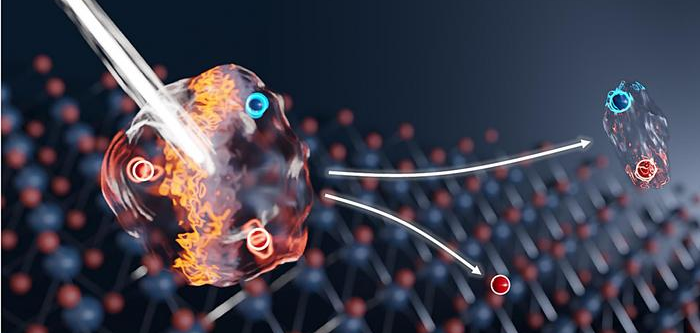A research team has succeeded in ultra-fast switching of tiny light sources within an ultra-thin, effectively two-dimensional material.
The result opens up new perspectives for research as well as for optical data processing and flexible detectors.
Trions exhibit electrical charge with strong light emission
Extremely thin materials consisting of just a few atomic layers promise applications for electronics and quantum technologies.
Two-dimensional semiconductors can exhibit fundamentally different properties compared to more conventional bulk crystals. In particular, it is easier to generate so-called exciton particles: If an electron, known to be negatively charged, is excited in the material by absorbing energy, it is removed from its original position. It leaves behind a mobile charge – a positively charged ‘hole’.
The electron and hole attract each other and form a bound state called an exciton, a kind of electronic pair. If another electron is nearby, it is pulled towards it to form a three-particle state – known as a trion. The special feature of the trion is the combination of electrical charge with strong light emission, which allows simultaneous electronic and optical control.
For quite some time, the interplay between exciton and trion has been considered as a switching process that could also be of interest for future applications. In fact, many laboratories have already succeeded in switching between the two states in a targeted manner – but so far with limited switching speeds.
The international team from TU Dresden and the Helmholtz-Zentrum Dresden-Rossendorf (HZDR) in Germany has now been able to significantly accelerate this switching. Researchers from Marburg, Rome, Stockholm and Tsukuba provided important contributions to the project.
A thousand times faster than previously possible
The experiments took place using the free-electron-laser facility (FELBE) at the HZDR, which is used to generate intense terahertz pulses. The researchers first illuminated an atomically-thin layer of molybdenum diselenide at cryogenic temperatures with short laser pulses, generating the excitons. As soon as they were created, each exciton captured an electron from those already present in sufficient numbers in the material, and thus became trions.

A strong light pulse in the terahertz range separates charged luminous trions into individual electrons and neutral excitons. Image: Giuseppe Meneghini
“When we then shot terahertz pulses at the material, the trions formed back into excitons extremely quickly,” explained physicist Dr Stephan Winnerl, who led the research at HZDR. “We were able to show it because excitons and trions emitted near-infrared radiation at different wavelengths.”
The decisive factor in the experiment was the matching frequency of the terahertz pulses to break the weak bond between the exciton and electron – hence a pair consisting of just one electron and one hole was recreated again. Soon afterwards, this exciton captures another electron and becomes a trion again.
The separation into excitons took place at record speed. The bond was broken within a few picoseconds – trillionths of a second. “This is almost a thousand times faster than previously possible with purely electronic methods and can be generated on demand with terahertz radiation,” said Professor Alexey Chernikov at TU Dresden.
The new method offers interesting prospects for research. The next step could be to extend the demonstrated processes to a variety of complex electronic states and material platforms. Unusual quantum states of matter, which arise from the strong interaction between many particles, would thus come within reach, as would applications at room temperature.
Prospects for data processing and sensor technology
The results could also become useful for future applications, for example in sensor technology or optical data processing. “It would be conceivable to adapt the effect for new types of modulators with rapid switching,” explained Winnerl. “In combination with the ultra-thin crystals, this could be used to develop components that are both extremely compact and capable of electronically controlling optically encoded information.”
Another field would be applications in the detection and imaging of technologically relevant terahertz radiation. “Based on the demonstrated switching processes in atomically thin semiconductors, it may be possible in the long term to develop detectors that work in the terahertz range, are adjustable in a wide frequency range, and could be realized as terahertz cameras featuring a large number of pixels,” said Chernikov.
“In principle, even a comparatively low intensity should be sufficient to trigger the switching process.” Converting trions to excitons leads to characteristic changes in the emitted near-infrared light wavelength. Detecting this and converting it into images would be fairly straightforward and could be achieved using already existing state-of-the-art technology.
The research was recently reported in Nature Photonics.


